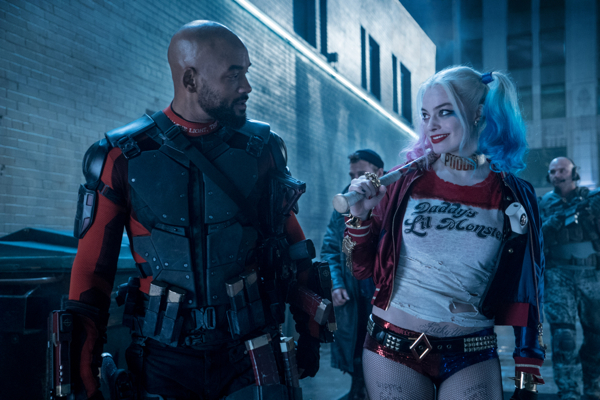Movie review by Greg Carlson
Filmmaker David Ayer’s “Fury” featured muscular action, effective use of screen space, coherent storytelling logic, and — even though we knew they were doomed from the first trailer — a ragtag group of soldiers with distinct personalities. Not surprisingly given the nonstop tales of creative second-guessing and executive interference, virtually none of these qualities are on hand in the frustrating “Suicide Squad,” a critic-proof franchise rocket launcher affiliated with Warner Bros.’ full-frontal assault on Disney/Marvel’s tentpole stranglehold over the wallets of fanboys and fangirls across the planet.
For many who follow the fortunes of (or are personally invested in) the cape-and-tights world at the multiplex, the behind-the-scenes saga of “Suicide Squad” is equally if not more compelling than the disappointing mess that finally showed up. In a must-read story in “The Hollywood Reporter,” Kim Masters notes, “…despite grueling moments, multiple editors and competing cuts, the production of ‘Suicide Squad’ barely stands out in today’s landscape.” In other words, we should all exercise some caution in blaming or praising Ayer alone when Masters traces the mind-boggling “intervention” that led to an apparent “six or seven different versions of the film” (according to the filmmaker).
The 123-minute presentation certainly feels like it has been smudged with the fingerprints of a small army of decision-makers, highlighting the dreariness of the movie’s principal engagement — a dispiriting bullet festival of urban combat and bad one-liners staged in a complex of steel and glass sets (as Anthony Lane asks rhetorically, “What are the chances for gun control, honestly, if this is what Hollywood… prefers to hold aloft…?”). If indeed Ayer’s vision was darker and/or grimmer still, perhaps the powers that be should have called in the staff of teaser editors Trailer Park much sooner.
Given the pronounced lack of teammate-focused interrelationships, “Suicide Squad” should have more closely followed the better instincts of inspiration “The Dirty Dozen,” the cinematic template for stories in which the worst of the worst are pressed into service to complete what looks like an impossible task. Instead of exploring the psyches, desires, and motivations of the Suicide Squad participants through action and dilemma-forced negotiation, Ayer’s script chokes by filtering the bulk of communication through outsiders Rick Flag (Joel Kinnaman) and Amanda Waller (Viola Davis), two authority figures with the power to terminate misbehaving metahumans/supervillains who might try to cut and run.
One final complaint must be registered regarding the visual presentation of the movie’s climactic crucible: the uninspired reliance on yet another column of computer generated energy geysering heavenward. As you watch the supremely potent Enchantress make the questionable decision to engage the Suicide Squad in close combat while simultaneously maintaining/monitoring the earth-to-sky gate that so lazily represents the AWESOME POWER of the story’s Big Bad, ask yourself where you might have seen this before (a few answers: “The Avengers” and several other MCU titles, obviously, but just this year “Warcraft” and “Ghostbusters”). Joshua Rivera devoted an entire post to it, astutely arguing that “‘Suicide Squad’ is more proof movies need to stop with the giant beams of light in the sky already.”
